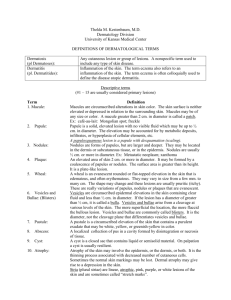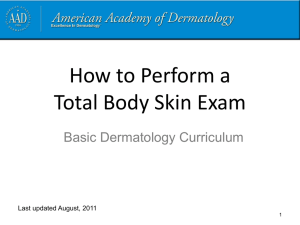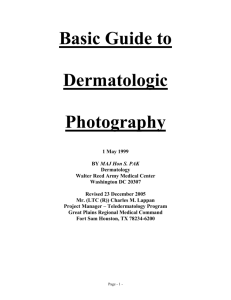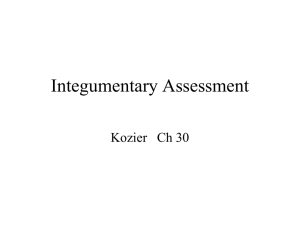Morphology - American Academy of Dermatology
advertisement
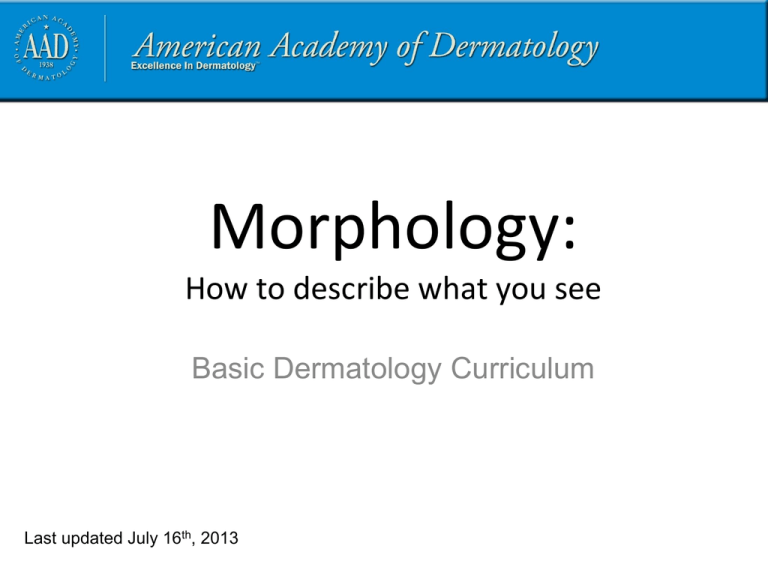
Morphology: How to describe what you see Basic Dermatology Curriculum Last updated July 16th, 2013 Module Instructions The following module contains a number of blue, underlined terms which are hyperlinked to the dermatology glossary, an illustrated interactive guide to clinical dermatology and dermatopathology. We encourage the learner to read all the hyperlinked information. 2 2 Goals and Objectives The purpose of this module is learn how to best describe skin lesions After completing this module, the learner will be able to: • Develop a systematic approach to describing skin eruptions • Utilize the appropriate terms to describe morphology 3 3 Morphology The word morphology is used by dermatologists to describe the form and structure of skin lesions The morphologic characteristics of skin lesions are key elements in establishing the diagnosis and communicating skin findings There are two steps in establishing the morphology of any given skin condition: 1. Careful visual and tactile inspection 2. Application of correct descriptors 4 4 Visual and Tactile Inspection Accumulate detailed information about the visual and tactile aspects of the skin findings Be able to communicate an accurate description so someone on the other end of a phone can get a mental picture of what you see. Question 1 • How would you fill in the description of the item depicted on the next slide? 5 5 Question 1 • How would you describe the object to the right? • Be as detailed as you can be! Question 1 This is a red, circular, shiny object with a small invagination on top. It measures 8 cm. It is in a white background and casts a shadow. 7 The shadow tells us it is raised (palpable). 7 Question 1 • This is a red, circular, shiny object with a small invagination on top. It measures 8 cm. It is in a white background and casts a shadow. The above description identifies: 1.Palpability (indicated by shadow) 2.Color 3.Shape 4.Texture 5.Size 6.Location 8 8 Application of the correct descriptors • We have just reviewed careful visual inspection • We will now define the terms dermatologists use to describe skin lesions • We will then have a series of cases for you to practice describing so you can use the correct descriptors. 9 9 Primary lesion: Macule (L. macula, “spot”) A macule is flat; if you can feel it, then it is not a macule. 10 10 Examples of Macules 11 11 Primary lesion: Patch Patches are flat but larger than macules If it’s flat and larger than 1 cm, it is a patch 12 12 Examples of Patches 13 13 Primary lesion: Papule (L. papula, “pimple”) Papules are raised lesions less than 1 cm It is caused by a proliferation of cells in epidermis or superficial dermis 14 14 Examples of Papules 15 15 Primary lesions: Plaque Plaques > 1 cm • You can feel them • They cast a shadow with side lighting It is also caused by a proliferation of cells in epidermis or superficial dermis 16 16 Examples of Plaques 17 17 Nodule (L. nodulus, “small knot”) It is caused by a proliferation of cells into the mid-deep dermis 18 18 Examples of Nodules 19 19 Primary lesion: Vesicle (L. vesicula, “little bladder”; bulla, “bubble”) Vesicles are fluidfilled papules (small blisters) A large (> 1cm) blister is called a bulla 20 vesicle bulla 20 Examples of Vesicles 21 21 Pustule Pus is made up of leukocytes and a thin fluid called liquor puris (L. “pus liquid”) See also furuncle and abscess 22 22 Erosion Erosions are loss of part or all of the epidermis They may occur after a vesicle forms and the top peels off They weep and become crusted 23 23 Ulcer (L. ulcus, “sore”) Ulcers are complete loss of the epidermis in addition to part of the dermis They often heal with scarring; erosions usually do not heal with scars 24 24 • Now you have the terms you need • Let’s practice your descriptions with cases • Do the best you can – like learning any new language it takes practice! Case One Mr. F 26 26 Case One: History HPI: Mr. F is a 32-year-old man who presents to his primary care provider with “blotches” on his upper back, chest, and arms for several years. They are more noticeable in the summertime. PMH: shoulder pain from an old sports injury Allergies: none Medications: NSAID as needed Family history: not contributory Social history: auto mechanic ROS: negative 27 27 10 Case One: Skin Exam 28 28 Case One How would you describe these skin findings? What do you see? Look carefully at all clues in the photographs. There are many right ways to describe something. Be creative. 29 29 12 Case One, Question 1 • Are these lesions elevated, flat, or depressed? 30 30 Case One, Question 1 • If you don’t feel an elevation or depression as your finger runs across the skin, they are flat – Small, flat lesions are called macules 31 31 Case One, Question 2 • How else can you describe them? – – – – What size are they? What shape are they? What color are they? How regular and distinct is the border? – How are they configured? – How are they distributed? 32 32 Case One, Question 2 • How else can you describe them? – 3 to 10 mm 33 33 Case One, Question 3 • How else can you describe them? – – – – What size are they? What shape are they? What color are they? How regular and distinct is the border? – How are they configured? – How are they distributed? 34 34 Case One, Question 3 • How else can you describe them? – 3 to 10 mm – Round to oval 35 35 Case One, Question 4 • How else can you describe them? – – – – What size are they? What shape are they? What color are they? How regular and distinct is the border? – How are they configured? – How are they distributed? 36 36 Case One, Question 4 • How else can you describe them? – 3 to 10 mm – Round to oval – Pink to tan 37 37 Case One, Question 5 • How else can you describe them? – – – – What size are they? What shape are they? What color are they? How regular and distinct is the border? – How are they configured? – How are they distributed? 38 38 Case One, Question 5 • How else can you describe them? – – – – 39 3 to 10 mm Round to oval Pink to tan Sharp, irregular borders 39 Case One, Question 6 • How else can you describe them? – – – – – 40 What size are they? What shape are they? What color are they? How distinct are they? How are they configured (how do the lesions relate to each other)? – How are they distributed (where are they on the body)? 40 Case One, Question 6 • How else can you describe them? – – – – – 41 3 to 10 mm Round to oval Pink to tan Sharp, irregular borders Separate, in no particular pattern 41 Case One, Question 7 • How else can you describe them? – – – – – – 42 What size are they? What shape are they? What color are they? How distinct are they? How are they configured? How are they distributed? 42 Case One, Question 7 • How else can you describe them? – – – – – 3 to 10 mm Round to oval Pink to tan Sharp, irregular borders Separate, in no particular pattern – On the upper chest, back, and flexures of arms 43 43 Skin Exam Mr. F’s skin exam shows: • Multiple 3 to 10 mm pink to tan-colored, round, flat lesions with sharp, irregular borders and varying sizes on his upper chest, back and flexures of the arms. Small (< 1cm) flat lesions are called macules In this case, the primary lesion is a macule 44 44 29 Diagnosis Dr. D performs a potassium hydroxide exam and based on the findings, diagnoses Mr. F with tinea versicolor. The primary lesion in tinea versicolor is a macule. 45 45 29 Case One, Question 8 Which of the following answers are correct? (More than one may be correct.) Macules can: a. Feel raised b. Feel flat c. Contain fluid d. Be any shape 46 46 Case One, Question 8 Answer: b & d Macules can: a. Feel raised (these are papules or plaques) b. Feel flat c. Contain fluid (these are vesicles or bullae) d. Be any shape 47 47 Review: Macule vs Patch MACULE (<1cm) PATCH (>1cm) 48 48 Case Two Mr. K 49 49 Case Two: History HPI: Mr. K is a 36-year-old man who presents with four years of itchy, flaky spots on his elbows, knees, and lower back. They have not improved with moisturizers. PMH: none Allergies: none Medications: none Family history: father died from heart attack at age 68 Social history: delivery truck driver Health-related behaviors: drinks 2-3 beers a week 50 ROS: negative 50 Case Two: Skin Exam 51 51 Case Two How would you describe these skin findings? Be as detailed as you can be! 52 52 42 Case Two, Question 1 • Are these lesions raised, flat, or depressed? 53 53 Case Two, Question 1 • Imagine running your finger over them. – These are raised – Large (>1cm), plateaulike, raised lesions are called plaques 54 54 Case Two, Question 1 • How else can you describe them? – – – – – – – 55 Size? Shape? Color? Sharp borders? Texture? Configuration? Distribution? 55 Case Two, Question 1 • How else can you describe them? 56 – 3 to 10 cm – Round to geographic (like outlines on a map) – Pink – Sharply circumscribed – Scaly – Symmetrical – Extensor surfaces (knees, elbows), back, 56 gluteal cleft Diagnosis Mr. K’s skin exam shows: • Several 3-10 cm pink round sharply circumscribed scaly plaques on his extensor elbows, knees, lower back, and gluteal cleft Mr. K has psoriasis. The primary lesion in this case of psoriasis is a plaque because it is elevated and over 1 cm in diameter. 57 57 47 Review: Papule vs Plaque PAPULE (<1cm) PLAQUE (>1cm) 58 58 Case Three Mr. B 59 59 Case Three HPI: Mr. B is a 28-year-old man who presents with four days of pain and blisters on his left chest. PMH: none Allergies: none Medications: none Family history: noncontributory Social history: single; works as a personal trainer 60 ROS: negative 60 Case Three 61 61 Case Three, Questions • How would you describe these skin findings? • Are these lesions raised, flat, or depressed? • Do they have fluid in them? 62 62 Case Three, Questions • These are raised • They also have fluid in them – Remember - small, raised, fluid-filled lesions are called vesicles 63 63 Case Three • How else can you describe them? – – – – – – 64 Size? Shape? Color? Texture? Configuration? Distribution? 64 Case Three • How else can you describe them? 65 – 2 – 5 mm – Round to oval – Clear, with a background erythematous patch – Fluid-filled – Grouped vesciles – Unilateral dermatomal distribution on the left chest 65 Distribution / Configuration Part of describing lesions is noting distribution and configuration Distribution means location(s) on the body Configuration means how the lesions are arranged or relate to each other • Lesions are grouped but also follow a linear pattern around the trunk • This is an example of a segmental or dermatomal distribution 66 66 Distribution / Configuration To learn more about distributions, click here: • http://bit.ly/itkitk To learn more about configurations, click here: • http://bit.ly/kbRI9Q • These links take you to LearnDerm, a free resource for learning morphology terms 67 67 Diagnosis Mr. B’s skin exam shows: • Grouped 2-5 mm vesicles on an erythematous base in a unilateral, dermatomal configuration on the left chest Small, fluid-filled lesions are called vesicles Mr. K has shingles. The primary lesion in shingles is a vesicle. 68 68 65 Review: Seeing the skin To describe what you see on the skin, first determine the primary lesion • Is it raised, flat, or depressed? • Is it small or large? • Is it fluid-filled? The table in the next slide summarizes most of the terms used to describe the skin. We have already reviewed many of them. Click on the others to learn more. 69 69 Terms Raised Flat Depressed Fluid-filled Vascular Papule Macule Erosion Vesicle Telangiectasia Plaque Patch Ulcer Bulla Petechiae Nodule Atrophy Pustule Ecchymosis Tumor Sinus Furuncle Wheal Stria Abscess Burrow Scar 70 70 Review: Seeing the skin In your descriptions, include adjectives that help describe the primary lesions. Make sure to consider: 71 Size Shape Color Texture Configuration Distribution 71 Take Home Points To describe the skin, first inspect closely Second, determine if the lesion is raised, flat, or depressed and its size. Then pick the term for the lesions that fits best! Finally, use adjectives relating to the shape, color, texture, distribution, and configuration to further describe the lesion. See the resources at the end for further reading. 72 72 Acknowledgements This module was developed by the American Academy of Dermatology’s Medical Student Core Curriculum Workgroup from 2008-2012. Primary authors: Patrick McCleskey, MD, FAAD; Peter A. Lio, MD, FAAD; Jacqueline C. Dolev, MD, FAAD; Amit Garg, MD, FAAD. Peer reviewers: Heather Woodworth Wickless, MD, MPH; Ron Birnbaum, MD; Timothy G. Berger, MD, FAAD. Revisions: Sarah D. Cipriano, MD, MPH, Jessica Kaffenberger, MD, Joslyn Kirby, MD. Last revised July 2013. 73 73 Resources Berger T, Hong J, Saeed S, Colaco S, Tsang M, Kasper R. The WebBased Illustrated Clinical Dermatology Glossary. MedEdPORTAL; 2007. Available from: www.mededportal.org/publication/462. Morphology illustrations are from the Dermatology Lexicon Project, which is now maintained by the American Academy of Dermatology as DermLex. Dolev JC, Friedlaender JK, Braverman, IM. Use of fine art to enhance visual diagnostic skills. JAMA 2001; 286(9), 100-2. Habif TP. Clinical Dermatology: a color guide to diagnosis and therapy, 4th ed. New York, NY: Mosby; 2004. James WD, Berger TG, Elston DM. Andrews’ Diseases of the Skin, 11th ed. Elsevier; 2011:12-17. Marks Jr JG, Miller JJ. Lookingbill and Marks’ Principles of Dermatology, 4th ed. Elsevier; 2006. Review primary lesions and other morphologic terms at http://www.logicalimages.com/educationalTools/learnDerm.htm. 74 74
